
The Lone Star Flag is the official flag of the U.S. state of Texas. The flag, flown at homes and businesses statewide, is highly popular among Texans and is treated with a great degree of reverence and esteem within Texas. Along with the flag of Hawaii, it is one of two state flags to have previously served as a national flag of an independent country. In 2001, the North American Vexillological Association surveyed its members on the designs of the 72 U.S. state, territorial, and Canadian provincial flags and ranked the Texas flag second, behind New Mexico.
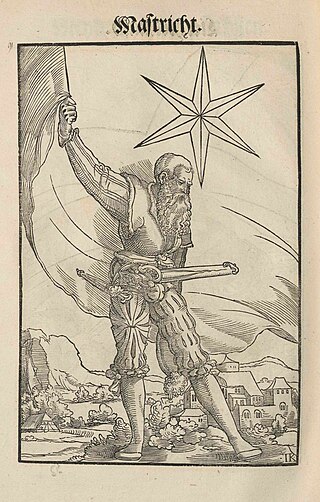
In heraldry, the term star may refer to any star-shaped charge with any number of rays, which may appear straight or wavy, and may or may not be pierced. While there has been much confusion between the two due to their similar shape, a star with straight-sided rays is usually called a mullet in English heraldry while one with wavy rays is usually called an estoile.

The national flag of Bosnia and Herzegovina contains a medium blue field with a yellow right triangle separating said field, and there are seven full five-pointed white stars and two half stars top and bottom along the hypotenuse of the triangle.

The Ohio Burgee is the official flag of the U.S. state of Ohio. It is a distinctive triangular swallowtail flag. Its red, white, and blue elements symbolize the state's natural features and order of admission into the Union. A prominent disc in the flag's triangular canton is suggestive of the state's name. The flag was adopted in 1902.

The state flag of the U.S. state of Minnesota consists of a dark blue field representing the night sky and the state's shape, an eight-pointed star representing the North Star, and a bright blue field representing the state's abundant waters; the star is based on one prominently featured in the Minnesota State Capitol rotunda.

The Beehive Flag is the official flag of the U.S. state of Utah. It is a horizontal tricolor with irregular bands of blue, white, and red. The middle white band contains a blue hexagon outlined in gold. Within the hexagon lies a gold-colored beehive, and below it sits a five-pointed white star.
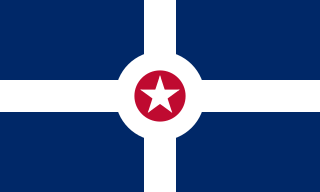
The flag of Indianapolis has a dark blue field with a white five-pointed star pointing upwards in the center. Around the star is a circular field in red. Surrounding the red field is a white ring, from which extend four white stripes from top to bottom and from hoist to fly, thus creating four equal quadrants in the field. The stripes are about one-seventh the width of the flag, with the white ring the same width as the stripes. The diameter of the red circle is about two-ninths the width of the flag.
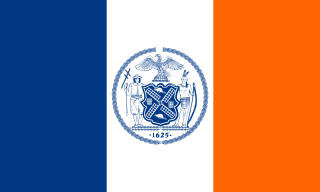
The flags of New York City include the flag of New York City, the respective flags of the boroughs of The Bronx, Brooklyn, Manhattan, Queens, and Staten Island, and flags of certain city departments. The city flag is a vertical tricolor in blue, white, and orange and charged in the center bar with the seal of New York City in blue. The tricolor design is derived from the flag of the Dutch Monarchy—the Prince's Flag—as used in New Amsterdam in 1625, when that city became the capital of New Netherland.
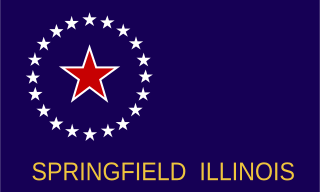
The flag of Springfield, Illinois was adopted in 1917. Its background is "Old Glory blue". The flag is emblazoned with a circle of 20 small, white stars, all pointed upward; the circle is offset, slightly, to the left of the flag. Those stars encircle a large, white-bordered "Old Glory red" star, also pointed upward. The center star is described as two stars, one atop the other, in the Springfield, Illinois Code of Ordinances. In the past, the flag has the words "Springfield Illinois," across its bottom; now photographs show no lettering on the flag, and governmental buildings have been seen sporting a version absent text.

The Betsy Ross flag is an early design for the flag of the United States, which is conformant to the Flag Act of 1777 and has red stripes outermost and stars arranged in a circle. These details elaborate on the 1777 act, passed early in the American Revolutionary War, which specified 13 alternating red and white horizontal stripes and 13 white stars in a blue canton. Its name stems from the story, once widely believed, that shortly after the 1777 act, upholsterer and flag maker Betsy Ross produced a flag of this design.
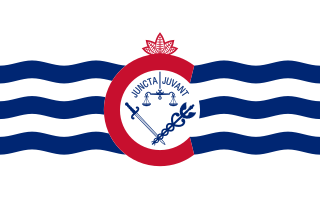
The flag of Cincinnati, Ohio was selected in an 1896 contest. It was formally adopted on June 15, 1940.
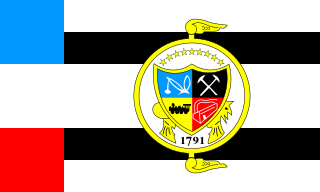
The city flag of Knoxville, Tennessee was officially adopted by municipal ordinance on October 16, 1896. It is the third oldest official city flag in the United States and the oldest flag of any state or city governmental entity in Tennessee.

The municipal flag of Provo, Utah, United States, features the city's logo on a light blue field. It was adopted on January 6, 2015, after a multi-year debate to replace the previous one. The former flag, adopted in 1989, was ridiculed in particular for its perceived ugliness and its similarity to the Centrum logo, and was voted one of the worst American city flags by the North American Vexillological Association (NAVA).

The city flag of Tulsa, Oklahoma consists of an upper navy blue half and a lower beige half, separated by a gold horizontal line, with a gold Osage shield punctuating the left third. The shield contains a red circle, and a beige six-pointed star centered within the circle. The flag is notable for being one of the few modern flags to utilize beige in its design - a color often associated with faded dyes on flags from usage.
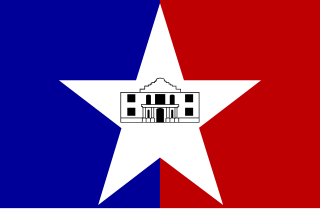
The city flag of San Antonio, Texas was originally drawn by Spanish–American War veteran William W. Herring on May 28, 1933. The design saw significantly more usage than the official flag, but was never officially adopted until 1976. The current flag is a slightly modified version of Herring's design, most notably removing the text formerly displayed.

The city flag of Austin, Texas consists of a white field with the seal of Austin without the surrounding circle of text. Below the seal of Austin is the text "CITY OF AUSTIN", written in blue and arched upwards.
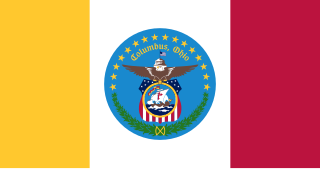
The current city flag of Columbus, Ohio is a yellow-white-red vertical triband with the city seal on a blue field. Officially, the flag was adopted in 1929, although it is unknown if the flag was ever flown when it was first adopted.
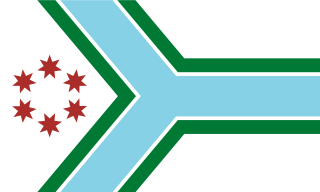
The municipal device of Chicago is a symbol used officially by the city of Chicago, Illinois, as well as unofficially by various agencies and companies associated with the city. As defined by city code, it consists of a Y shape inscribed inside of a circle. The symbol represents the north, south, and main branches of the Chicago River, and their confluence at Wolf Point. It was designed by Danish-born architect and civil engineer Alfred J. Råvad (Roewad). Its earliest known appearance was in 1892 for a contest to design the city's flag held by the Chicago Tribune. While this was ultimately not used for the flag, in 1917 it was officially adopted along with the flag and seal as symbols of the city of Chicago.
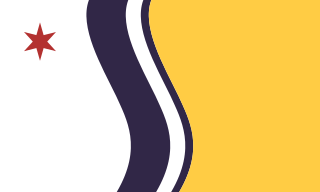
The flag of South Bend, Indiana was adopted by the city council during the mayorship of Pete Buttigieg on April 25, 2016. It is a field of white and yellow separated by a two blue curved lines with a white line between them and a red six-pointed star in the upper left corner.

The flag of Cook County, Illinois, nicknamed "I Will", consists of a light blue pall with a green border on a field of white. Six red stars with seven points each sit in a circle at the flag's hoist side, drawing cues from the city flag and other symbols of the county seat of Chicago and its in-county suburbs.






























